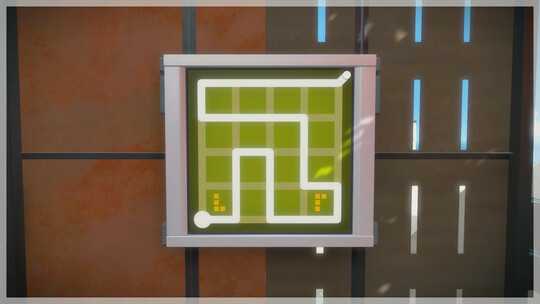3
1
Introduction
In the game The Witness (possible spoilers ahead) there is a group of puzzles that involve drawing a Tetris piece with your line while making sure that the symbol for the Tetris piece your currently drawing stays contained within the shape you've drawn.
For the image above the drawing works because the L-shaped and upside down L-shaped Tetris pieces, occupying the positions (1,2)(2,2)(3,2)(3,3) and (1,1)(1,0)(2,0)(3,0) respectively, and the icons, located at (3,0) and (3,3), are contained within the white line.
Challenge
Your goal is to draw the solution line such that it contains all Tetris pieces as well as their respective symbols. The solution line may not contain anymore squares than that which is required (i.e. you must contain the sum of the number of squares making up each Tetris piece). Each solution will begin in the bottom left and end in the top right. Lastly, this is code-golf, so the shortest solution (in bytes) wins.
Representation
Each of these puzzles use a HxW grid of squares to construct your Tetris pieces and have some space for you to draw lines in between them. The representation is best understood by example. For the above image the representation would be
===========
| |
| X X X X |
| |
| X X X X |
| |
| X X X X |
| |
| X X X X |
| |
===========
and the solution would be
===========
|*********|
|*X X X X |
|******* |
| X X X*X |
| *** * |
| X*X*X*X |
| * * ***|
| X*X*X X*|
|*** *****|
===========
where each square is represented by an X and the solution is drawn using a line of *s. The number of lines for each puzzle is 2*H+3 and the number of characters for each line is 2*W+3.
Input
The first n lines will give you the Tetris piece followed by the location of the corresponding symbol for that Tetris piece. The format is as follows:
(i1,j1)(i2,j2)...(ik,jk)->(p,q)
where (ik,jk) is the kth coordinate pair of the Tetris piece
(the left coordinate increases as you move down, the right coordinate increases as you move right) and (p,q) is the location of the corresponding symbol. The origin of each Tetris piece is the top left square (i.e. the top left square is (0,0)).
Example 1:
X
X
XX
would be
(0,0)(1,0)(2,0)(2,1)
Example 2:
XX
X
X
would be
(0,0)(1,0)(2,0)(0,1)
Example 3:
X X
X X
would be
(0,0)(1,0)(0,3)(1,3)
The next 2*H+3 lines will consist of the puzzle's grid.
Output
Output the puzzle grid with the solution line drawn in.
Examples
Example Input 1
(0,0)(0,1)->(2,1)
(0,0)(0,1)->(0,1)
(0,0)->(0,2)
=========
| |
| X X X |
| |
| X X X |
| |
| X X X |
| |
=========
Example Output 1
=========
|*******|
|*X X X |
|*******|
| X X X*|
|***** *|
|*X X*X*|
|* ***|
=========
Example Input 2
(0,0)(0,1)(0,2)(1,2)(2,2)->(0,0)
(0,0)(1,0)(0,3)(1,3)->(2,1)
(0,0)(1,0)(2,0)->(1,3)
===========
| |
| X X X X |
| |
| X X X X |
| |
| X X X X |
| |
| X X X X |
| |
===========
Example Output 2
===========
| ***|
| X X X*X |
| ***|
| X X X X*|
| *|
| X X X X*|
|*** *****|
|*X*X*X X |
|* *** |
===========
Example Input 3
(0,0)(1,0)(2,0)->(1,0)
(0,0)(1,0)(2,0)->(1,6)
(0,0)(0,1)(0,2)->(1,3)
=================
| |
| X X X X X X X |
| |
| X X X X X X X |
| |
| X X X X X X X |
| |
=================
Example Output 3
=================
|*** ***|
|*X*X X X X X*X |
|* ******* * |
|*X X X X*X X*X |
|* ******* * |
|*X*X X X X X*X |
|* *********** |
=================
Clarifications
- It is assumed that for any given input there is a solution.
- If there are multiple solutions just print one.

Can we assume there is always a solution? Can we assume the solution is always unique? – Martin Ender – 2016-11-28T10:42:24.417
Since the challenge is modeled off of the game there is always a solution for every puzzle and there may be more than 1 solution. – Bobas_Pett – 2016-11-28T10:44:26.143
In that case, do we print any one solution or all of them? – Martin Ender – 2016-11-28T10:50:16.543
Yeah, any valid solution. – Bobas_Pett – 2016-11-28T10:57:36.047
The introduction makes very little sense to me. What's the coordinate system? In what sense is there a "Tetris piece your currently drawing"? – Peter Taylor – 2016-11-28T22:30:36.190
@Peter Taylor -- The coordinates I use in the introduction are referring to the 4x4 grid in the picture, where the top left green square is at
(0,0)and the bottom right green square is at(3,3), the left coordinate is up-down and the right coordinate is left-right. The Tetris pieces are defined by the symbols, so in the picture they have an L shaped one located at the bottom left and a upside down (reflected) L shaped one located at the bottom right. These Tetris pieces in the image fully occupy a section in the grid (defined by the white line and the grid border). – Bobas_Pett – 2016-11-28T23:41:18.807